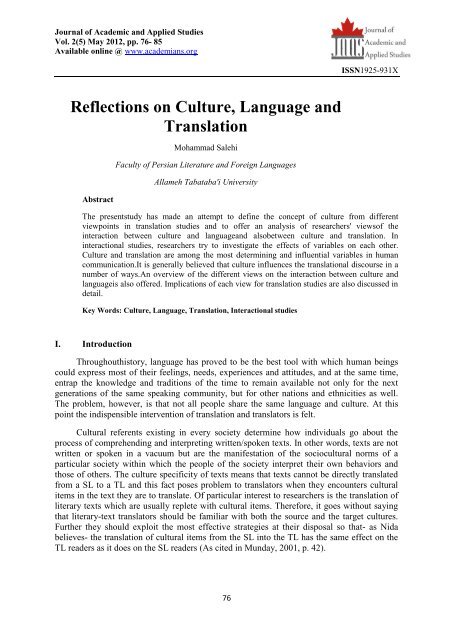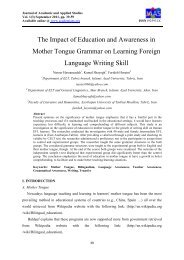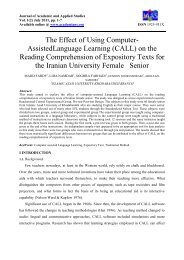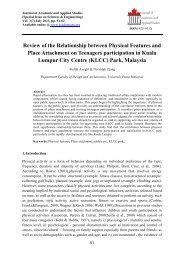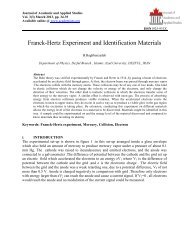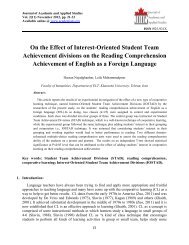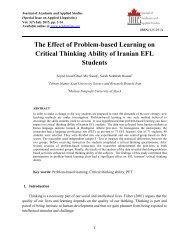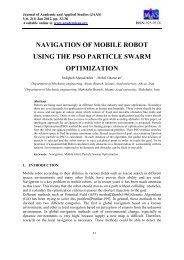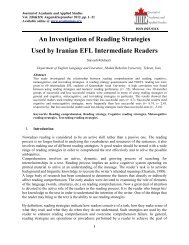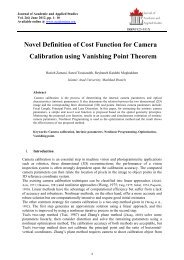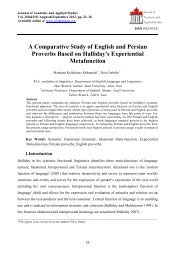Reflections on Culture, Language and Translation - Journal of ...
Reflections on Culture, Language and Translation - Journal of ...
Reflections on Culture, Language and Translation - Journal of ...
Create successful ePaper yourself
Turn your PDF publications into a flip-book with our unique Google optimized e-Paper software.
<strong>Journal</strong> <strong>of</strong> Academic <strong>and</strong> Applied Studies<br />
Vol. 2(5) May 2012, pp. 76- 85<br />
Available <strong>on</strong>line @ www.academians.org<br />
ISSN1925-931X<br />
<str<strong>on</strong>g>Reflecti<strong>on</strong>s</str<strong>on</strong>g> <strong>on</strong> <strong>Culture</strong>, <strong>Language</strong> <strong>and</strong><br />
Translati<strong>on</strong><br />
Abstract<br />
Mohammad Salehi<br />
Faculty <strong>of</strong> Persian Literature <strong>and</strong> Foreign <strong>Language</strong>s<br />
Allameh Tabataba'i University<br />
The presentstudy has made an attempt to define the c<strong>on</strong>cept <strong>of</strong> culture from different<br />
viewpoints in translati<strong>on</strong> studies <strong>and</strong> to <strong>of</strong>fer an analysis <strong>of</strong> researchers' views<strong>of</strong> the<br />
interacti<strong>on</strong> between culture <strong>and</strong> language<strong>and</strong> alsobetween culture <strong>and</strong> translati<strong>on</strong>. In<br />
interacti<strong>on</strong>al studies, researchers try to investigate the effects <strong>of</strong> variables <strong>on</strong> each other.<br />
<strong>Culture</strong> <strong>and</strong> translati<strong>on</strong> are am<strong>on</strong>g the most determining <strong>and</strong> influential variables in human<br />
communicati<strong>on</strong>.It is generally believed that culture influences the translati<strong>on</strong>al discourse in a<br />
number <strong>of</strong> ways.An overview <strong>of</strong> the different views <strong>on</strong> the interacti<strong>on</strong> between culture <strong>and</strong><br />
languageis also <strong>of</strong>fered. Implicati<strong>on</strong>s <strong>of</strong> each view for translati<strong>on</strong> studies are also discussed in<br />
detail.<br />
Key Words: <strong>Culture</strong>, <strong>Language</strong>, Translati<strong>on</strong>, Interacti<strong>on</strong>al studies<br />
I. Introducti<strong>on</strong><br />
Throughouthistory, language has proved to be the best tool with which human beings<br />
could express most <strong>of</strong> their feelings, needs, experiences <strong>and</strong> attitudes, <strong>and</strong> at the same time,<br />
entrap the knowledge <strong>and</strong> traditi<strong>on</strong>s <strong>of</strong> the time to remain available not <strong>on</strong>ly for the next<br />
generati<strong>on</strong>s <strong>of</strong> the same speaking community, but for other nati<strong>on</strong>s <strong>and</strong> ethnicities as well.<br />
The problem, however, is that not all people share the same language <strong>and</strong> culture. At this<br />
point the indispensible interventi<strong>on</strong> <strong>of</strong> translati<strong>on</strong> <strong>and</strong> translators is felt.<br />
Cultural referents existing in every society determine how individuals go about the<br />
process <strong>of</strong> comprehending <strong>and</strong> interpreting written/spoken texts. In other words, texts are not<br />
written or spoken in a vacuum but are the manifestati<strong>on</strong> <strong>of</strong> the sociocultural norms <strong>of</strong> a<br />
particular society within which the people <strong>of</strong> the society interpret their own behaviors <strong>and</strong><br />
those <strong>of</strong> others. The culture specificity <strong>of</strong> texts means that texts cannot be directly translated<br />
from a SL to a TL <strong>and</strong> this fact poses problem to translators when they encounters cultural<br />
items in the text they are to translate. Of particular interest to researchers is the translati<strong>on</strong> <strong>of</strong><br />
literary texts which are usually replete with cultural items. Therefore, it goes without saying<br />
that literary-text translators should be familiar with both the source <strong>and</strong> the target cultures.<br />
Further they should exploit the most effective strategies at their disposal so that- as Nida<br />
believes- the translati<strong>on</strong> <strong>of</strong> cultural items from the SL into the TL has the same effect <strong>on</strong> the<br />
TL readers as it does <strong>on</strong> the SL readers (As cited in Munday, 2001, p. 42).<br />
76
<strong>Journal</strong> <strong>of</strong> Academic <strong>and</strong> Applied Studies<br />
Vol. 2(5) May 2012, pp. 76- 85<br />
Available <strong>on</strong>line @ www.academians.org<br />
ISSN1925-931X<br />
II.<br />
On Defining <strong>Culture</strong><br />
One <strong>of</strong> the oldest <strong>and</strong> most quoted definiti<strong>on</strong>s <strong>of</strong> culture was formulated by the<br />
English anthropologist Edward Burnett Tylor in 1871. "<strong>Culture</strong> is that complex whole which<br />
includes knowledge, belief, art, morals, law, customs <strong>and</strong> any other capabilities <strong>and</strong> habits<br />
acquired by man as a member <strong>of</strong> society" (As quoted in Katan 1999, p. 16).<br />
By 1952, two American anthropologists Alfred Louis Kroeber <strong>and</strong> Clyde Kluckhohn<br />
(1961, p. 181) had compiled a list <strong>of</strong> 164 definiti<strong>on</strong>s. Their lengthy (165 th ) c<strong>on</strong>tributi<strong>on</strong> was as<br />
follows:<br />
<strong>Culture</strong> c<strong>on</strong>sists <strong>of</strong> patterns, explicit <strong>and</strong> implicit <strong>of</strong> <strong>and</strong> for behavior acquired<br />
<strong>and</strong> transmitted by symbols, c<strong>on</strong>stituting the distinctive achievement <strong>of</strong><br />
human groups, including their embodiment in artefacts; the essential core <strong>of</strong><br />
culture c<strong>on</strong>sists <strong>of</strong> traditi<strong>on</strong>al (i.e., historically derived <strong>and</strong> selected) ideas <strong>and</strong><br />
especially their attached values. <strong>Culture</strong> systems may, <strong>on</strong> the <strong>on</strong>e h<strong>and</strong>, be<br />
c<strong>on</strong>sidered as products <strong>of</strong> acti<strong>on</strong>, <strong>on</strong> the other h<strong>and</strong>, as c<strong>on</strong>diti<strong>on</strong>ing elements<br />
<strong>of</strong> future acti<strong>on</strong>. (As quoted in Katan, 1999, p. 16)<br />
There are different views about the c<strong>on</strong>cept <strong>of</strong> culture <strong>and</strong> as a result its definiti<strong>on</strong>.<br />
Trompenaars (1993, p. 22) admits that "In fifteen years I have seldom encountered two or<br />
more groups or individuals with identical suggesti<strong>on</strong>s regarding the c<strong>on</strong>cept <strong>of</strong> culture"(As<br />
quoted in Katan, 1999, p. 16).<br />
Vermeer believes that "culture c<strong>on</strong>sists <strong>of</strong> everything <strong>on</strong>e needs to know, master <strong>and</strong><br />
feel, in order to assess where members <strong>of</strong> a society are behaving acceptably or deviantly in<br />
their various roles" (As quoted in Katan, 2009, p. 82).<br />
Katan (2009, p. 74) claims that as l<strong>on</strong>g as time passes <strong>and</strong> new fields <strong>of</strong> studies come<br />
to an existence the c<strong>on</strong>cept <strong>of</strong> culture changes in human's mind.<br />
Originally, culture was simple. It referred exclusively to the humanist ideal <strong>of</strong><br />
what was civilized in developed society (the educati<strong>on</strong> system, the arts,<br />
architecture). Then a sec<strong>on</strong>d meaning, the way <strong>of</strong> life <strong>of</strong> a people, took place<br />
al<strong>on</strong>gside. Emphasis at the time was very much <strong>on</strong> 'primitive' cultures <strong>and</strong><br />
tribal practices. With the development <strong>of</strong> sociology <strong>and</strong> cultural studies, a<br />
third meaning has emerged, related to forces in society or ideology.<br />
Life <strong>and</strong> the style <strong>of</strong> living is <strong>on</strong>e <strong>of</strong> the key points in defining the c<strong>on</strong>cept <strong>of</strong> culture.<br />
Newmark's definiti<strong>on</strong> <strong>of</strong> culture is as follows:<br />
"The way <strong>of</strong> life <strong>and</strong> its manifestati<strong>on</strong>s that are peculiar to a community that uses a particular<br />
language as its means <strong>of</strong> expressi<strong>on</strong>" (1988, p. 94)<br />
Agar too in defining culture relates it to real life:<br />
77
<strong>Journal</strong> <strong>of</strong> Academic <strong>and</strong> Applied Studies<br />
Vol. 2(5) May 2012, pp. 76- 85<br />
Available <strong>on</strong>line @ www.academians.org<br />
ISSN1925-931X<br />
<strong>Culture</strong> is …what happens to you when you encounter differences, become<br />
aware <strong>of</strong> something in yourself, <strong>and</strong> work to figure out why the differences<br />
appeared. <strong>Culture</strong> is an awareness, a c<strong>on</strong>sciousness, <strong>on</strong>e that reveals the hidden<br />
self <strong>and</strong> opens path, to other ways <strong>of</strong> being. (Agar, 1994, p. 20)<br />
Although it is said that there is no two definiti<strong>on</strong>s <strong>of</strong> culture that are identical, all<br />
definiti<strong>on</strong>s have got elements that are repeated similarly in them. For example, elements <strong>of</strong><br />
belief <strong>and</strong> value, even if not stated explicitly, have been implied in majority <strong>of</strong> them.<br />
Lars<strong>on</strong> (1984, p. 430) defines culture as "a complex <strong>of</strong> beliefs, attitudes, values, <strong>and</strong><br />
rules which a group <strong>of</strong> people share".<br />
Hester <strong>and</strong> Eglin have somehow a different view. They believe that culture is in acti<strong>on</strong> <strong>and</strong><br />
declare:<br />
Not just that members use culture to do things, but that culture is c<strong>on</strong>stituted in<br />
<strong>and</strong> <strong>on</strong>ly exists in, acti<strong>on</strong>. For membership categorizati<strong>on</strong> analysis, this means<br />
that the orderliness <strong>of</strong> cultural resources (categories, devices <strong>and</strong> the rest) is<br />
c<strong>on</strong>stituted in their use rather than preexisting. (Hester <strong>and</strong> Eglin, 1997, p. 20)<br />
Finally, according to the Encyclopedia <strong>of</strong> language <strong>and</strong> linguistics, Asher (1994, p.<br />
2001) c<strong>on</strong>firms that "Despite a century <strong>of</strong> efforts to define culture adequately, there was in<br />
the early 1990s no agreement am<strong>on</strong>g anthropologists regarding its nature" (As quoted in<br />
Katan 1999, p. 17).<br />
However, defining culture is important not as an academic exercise, but because the<br />
definiti<strong>on</strong> delimits how culture is perceived <strong>and</strong> taught. As Katan (1999, p. 17) claims <strong>and</strong><br />
quotes from CED 1991, in defining the c<strong>on</strong>cept <strong>of</strong> culture all words should deliberately be<br />
chosen. He states that "if we define culture in terms <strong>of</strong> 'the artistic <strong>and</strong> social pursuits,<br />
expressi<strong>on</strong>s <strong>and</strong> tastes valued by a society or class we will be teaching nati<strong>on</strong>al literature,<br />
sports <strong>and</strong> hobbies".<br />
III. <strong>Language</strong> <strong>and</strong> <strong>Culture</strong><br />
"The heavy stress <strong>on</strong> language as an aspect <strong>of</strong> cultural identity", as lambert (2000,<br />
p. 166) says, "is <strong>of</strong> course not new at all. It is even rather comm<strong>on</strong> in historical <strong>and</strong> cultural<br />
research, in anthropology, history, pragmatics, literary studies, etc". Lambert adds that<br />
"more important are the fluctuati<strong>on</strong>s, c<strong>on</strong>tradicti<strong>on</strong>s, <strong>and</strong> hesitati<strong>on</strong>s in the treatment <strong>of</strong> the<br />
basic questi<strong>on</strong>, 'Has culture anything to do with language', or:'Is language a distinctive<br />
feature in matters <strong>of</strong> cultural identity"(p. 166). He believes that rather than answering by a<br />
simple 'yes' or 'no', it is better to examine where <strong>and</strong> when the answer tends to become 'yes'<br />
or 'no', <strong>and</strong> what the backgrounds are for such answers, <strong>and</strong> the c<strong>on</strong>sequences for the<br />
treatment <strong>of</strong> cultural matters, especially in the 'age <strong>of</strong> mobility'.<br />
In Katan's (1999) opini<strong>on</strong>, Malinowski was <strong>on</strong>e <strong>of</strong> the first anthropologists to<br />
realize that language could <strong>on</strong>ly be understood with reference to culture. In 1923 he coined<br />
the term 'c<strong>on</strong>text <strong>of</strong> situati<strong>on</strong>' <strong>and</strong> noted that a language could <strong>on</strong>ly be fully understood, i.e.<br />
78
<strong>Journal</strong> <strong>of</strong> Academic <strong>and</strong> Applied Studies<br />
Vol. 2(5) May 2012, pp. 76- 85<br />
Available <strong>on</strong>line @ www.academians.org<br />
ISSN1925-931X<br />
have meaning, when this two c<strong>on</strong>texts (situati<strong>on</strong> <strong>and</strong> culture) were implicitly or explicitly<br />
clear to the interlocutors <strong>and</strong> hearers (Katan 1999, p. 72).<br />
Boas (1986) broached the subject <strong>of</strong> culture <strong>and</strong> discussed the links between<br />
language, thought <strong>and</strong> the native envir<strong>on</strong>ment. Boas felt that language was not in itself a<br />
barrier to thought but that there was a dynamic relati<strong>on</strong>ship between language, culture <strong>and</strong><br />
thought. His key point was succinctly put as follows:"the form <strong>of</strong> the language will be<br />
moulded by the state <strong>of</strong> that culture".<br />
There are many comments <strong>on</strong> the relati<strong>on</strong>ship between language <strong>and</strong> culture.<br />
Although the majority c<strong>on</strong>firms the language <strong>and</strong> culture as c<strong>on</strong>cepts indispensible, some<br />
hypotheses insist <strong>on</strong> the irrelevancy <strong>of</strong> these two c<strong>on</strong>cepts.<br />
Malinowski (1938, p. 305) extremely claims that "language is essentially rooted in<br />
the reality <strong>of</strong> the culture… it cannot be explained without c<strong>on</strong>stant reference to these<br />
broader c<strong>on</strong>texts <strong>of</strong> verbal utterances" (As quoted in Katan 1999, p. 72).<br />
Bennet (1998, p. 3) has somehow the same view. He explains that the "fundamental<br />
premise <strong>of</strong> 'the intercultural communicati<strong>on</strong> approach' is that 'cultures are different in their<br />
languages, behavior patterns', <strong>and</strong> values". So as Munday infer <strong>of</strong> this statement "an<br />
attempt to use [m<strong>on</strong>ocultural] self as a predictor <strong>of</strong> shared assumpti<strong>on</strong>s <strong>and</strong> resp<strong>on</strong>ses to<br />
messages is unlikely to work' – because the resp<strong>on</strong>se, in our case to a translati<strong>on</strong>, will be<br />
ethnocentric" (Munday, 2009, p. 74).<br />
O'C<strong>on</strong>nor <strong>and</strong> Seymour (1990, p. 131) report that more recently, NLP has also taken the<br />
view that meaning in communicati<strong>on</strong> is culture-bound:"We learn what things mean from<br />
our culture <strong>and</strong> individual upbringing" (As quoted in Katan 1999, p. 73).<br />
H<strong>on</strong>gwei (1999) believes in language as a portrait <strong>of</strong> culture. He says that<br />
"language mirrors other parts <strong>of</strong> culture, supports them, spreads them <strong>and</strong> helps to develop<br />
others" (p.121). This special feature <strong>of</strong> language distinguishes it from all other facets <strong>of</strong><br />
culture <strong>and</strong> makes it crucially important for the transfer <strong>of</strong> culture. It is no exaggerati<strong>on</strong> to<br />
say that, as H<strong>on</strong>gwei believes too, "language is the life-blood <strong>of</strong> culture <strong>and</strong> that culture is<br />
the track al<strong>on</strong>g which language forms <strong>and</strong> develops" (p. 121). The formati<strong>on</strong> <strong>and</strong><br />
development <strong>of</strong> all aspects <strong>of</strong> a culture are closely related to <strong>on</strong>e another, <strong>and</strong> language is<br />
no excepti<strong>on</strong>. A careful study <strong>of</strong> the meanings <strong>of</strong> words <strong>and</strong> how these change dem<strong>on</strong>strate<br />
how material culture, instituti<strong>on</strong>al culture <strong>and</strong> mental culture influence the formati<strong>on</strong> <strong>and</strong><br />
development <strong>of</strong> language (H<strong>on</strong>gwei, 1999, p. 123).<br />
Two <strong>of</strong> the most vigorous exp<strong>on</strong>ents <strong>of</strong> the role <strong>of</strong> culture in language were, <strong>of</strong><br />
course, Sapir <strong>and</strong> his pupil Benjamin Lee Whorf. It is a testim<strong>on</strong>y to their ground-breaking<br />
<strong>and</strong> c<strong>on</strong>troversial ideas that they are still discussed today. The Sapir-Whorf hypothesis has<br />
an obligatory place in all c<strong>on</strong>temporary text books that touch up<strong>on</strong> the subject, even though<br />
the hypothesis was put <strong>on</strong> paper before the 1939 (As cited in Katan, 1999, p. 74).<br />
Sapir (1929, p. 214), like Malinowski, was c<strong>on</strong>vinced that language could <strong>on</strong>ly be<br />
interpreted within a culture. However, he went further, suggesting that "no two languages<br />
are ever sufficiently similar to be c<strong>on</strong>sidered as representing the same reality. The worlds<br />
79
<strong>Journal</strong> <strong>of</strong> Academic <strong>and</strong> Applied Studies<br />
Vol. 2(5) May 2012, pp. 76- 85<br />
Available <strong>on</strong>line @ www.academians.org<br />
ISSN1925-931X<br />
in which different societies live are distinct worlds, not merely the same world with<br />
different labels"(As quoted in Katan, 1999). This well-known extract c<strong>on</strong>stitutes part <strong>of</strong><br />
what is known as the Sapir-Whorf Hypothesis, <strong>of</strong> which there have traditi<strong>on</strong>ally been two<br />
versi<strong>on</strong>s:the str<strong>on</strong>g <strong>and</strong> the weak.<br />
In the str<strong>on</strong>g view, language actually determines the way the language user thinks,<br />
which would suggest, for example, that bilinguals would automatically change their view<br />
<strong>of</strong> the world as they change language. This has few supporters today. Katan (1999, p. 74)<br />
believes that:<br />
If the str<strong>on</strong>g versi<strong>on</strong> <strong>of</strong> the Sapir-Whorf Hypothesis were accepted, this<br />
would mean that people, hence translators <strong>and</strong> interpreters too, would be<br />
'pris<strong>on</strong>ers' <strong>of</strong> their native language <strong>and</strong> would be incapable <strong>of</strong> c<strong>on</strong>ceptualizing<br />
in categories other than those <strong>of</strong> our native t<strong>on</strong>gue. It is now widely<br />
recognized that such a view is untenable.<br />
Sapir introduces his essay <strong>on</strong> '<strong>Language</strong> Race <strong>and</strong> <strong>Culture</strong>' (1949, p. 207) with these<br />
words:"<strong>Language</strong> has a setting … language does not exist apart from culture" (As quoted<br />
in Katan, 1999, p. 73). On the c<strong>on</strong>trary, Newmark (1988, p. 95) does not regard language<br />
as a comp<strong>on</strong>ent or feature <strong>of</strong> culture. He believes that "if it were so, translati<strong>on</strong> would be<br />
impossible".<br />
Based <strong>on</strong> the weak versi<strong>on</strong> <strong>of</strong> the Sapir-Whorf theory, it is suggested that language<br />
has a tendency to influence thought. This versi<strong>on</strong> <strong>of</strong> the theory has many more supporters<br />
in anthropology, linguistics <strong>and</strong> translati<strong>on</strong>. Supporters <strong>of</strong> the weak versi<strong>on</strong> suggest that<br />
language is <strong>on</strong>e <strong>of</strong> the factors influencing our underst<strong>and</strong>ing <strong>of</strong> reality, but it is not the<br />
determining factor. According to the Logical Level model, the determining factors are, as<br />
Reddick (1992) suggests, beliefs <strong>and</strong> values (As cited in Katan, 1999, p. 74).<br />
Lambert (2000) believes that Cultural Studies, from its beginning, has isolated itself<br />
from linguistics <strong>and</strong>/or the study <strong>of</strong> language. As an example he refers to literary<br />
envir<strong>on</strong>ment where Cultural Studies has originated but the questi<strong>on</strong> <strong>of</strong> language was not<br />
the real issue. He c<strong>on</strong>tinues that except in branches such as sociolinguistics, pragmatics or<br />
discourse analysis, the link between language <strong>and</strong> identity was not at all a central issue for<br />
linguists either, which has put it into kind <strong>of</strong> a no-man's l<strong>and</strong>. Lambert directs his criticism<br />
to literary scholars <strong>and</strong> academic instituti<strong>on</strong>s which have structured their organizati<strong>on</strong> <strong>of</strong><br />
departments <strong>and</strong> curricula <strong>on</strong> the basis <strong>of</strong> nati<strong>on</strong>al literature but the role played by the<br />
(nati<strong>on</strong>al) language has been hardly questi<strong>on</strong>ed:"it is taken for granted that nati<strong>on</strong>al<br />
literatures have their nati<strong>on</strong>al language, <strong>on</strong>ce <strong>and</strong> for all" (p. 166).<br />
In social psychology <strong>and</strong> communicati<strong>on</strong> studies too, as lambert (Lambert, 2000, p.<br />
166) reports, the language comp<strong>on</strong>ents is hardly taken into c<strong>on</strong>siderati<strong>on</strong> when cultural<br />
awareness has become quite central. Communicati<strong>on</strong> studies or even ec<strong>on</strong>omics overlook<br />
language <strong>and</strong> the verbal comp<strong>on</strong>ent as a rather peripheral difficulty when dealing with<br />
globalizati<strong>on</strong>.<br />
The most striking observati<strong>on</strong> is that the discipline completely in the service <strong>of</strong><br />
language, i.e. linguistics, has paid little attenti<strong>on</strong> to the questi<strong>on</strong> <strong>of</strong> culture <strong>and</strong> identity <strong>and</strong><br />
80
<strong>Journal</strong> <strong>of</strong> Academic <strong>and</strong> Applied Studies<br />
Vol. 2(5) May 2012, pp. 76- 85<br />
Available <strong>on</strong>line @ www.academians.org<br />
ISSN1925-931X<br />
has not even discovered to what extent language might be c<strong>on</strong>stitutive <strong>of</strong> society (Lambert,<br />
2000, p. 166). Lambert states that just a few areas in linguistics such as sociolinguistics,<br />
discourse analysis or pragmatics have broken the spell, p. "their degree <strong>of</strong> expertise is very<br />
high, <strong>and</strong> their c<strong>on</strong>tributi<strong>on</strong> to our knowledge <strong>of</strong> culture is fundamental" (Lambert, 2000, p.<br />
166). In his belief the difficulty is that "their insights are not really recognized within the<br />
core <strong>of</strong> the discipline" (Lambert, 2000, p. 166).<br />
As his last criticism, Lambert (Lambert, 2000, p. 166) states that although many<br />
links between culture <strong>and</strong> language may be approached in any area <strong>of</strong> the humanities<br />
(including law, ec<strong>on</strong>omics, experimental psychology), there is no instituti<strong>on</strong>alized nor even<br />
widely accepted space for it, <strong>and</strong> that those who actually take it seriously are very eclectic<br />
in reading publicati<strong>on</strong>s from the other disciplines.<br />
As the last point in this part reviewing Kramsch's belief <strong>on</strong> the relati<strong>on</strong>ship between<br />
language <strong>and</strong> culture is worthwhile. She believes that:<br />
<strong>Language</strong> is a system <strong>of</strong> signs that is seen as having itself a cultural value.<br />
Speakers identify themselves <strong>and</strong> others through their use <strong>of</strong> language:they<br />
view their language as a symbol <strong>of</strong> their social identity. The prohibiti<strong>on</strong> <strong>of</strong> its<br />
use is <strong>of</strong>ten perceived by its speakers as a rejecti<strong>on</strong> <strong>of</strong> their social group <strong>and</strong><br />
their culture. Thus we can say that language symbolizes cultural reality<br />
(Kramsch, 1998, p. 3).<br />
IV.<br />
Translati<strong>on</strong> <strong>and</strong> <strong>Culture</strong><br />
Any<strong>on</strong>e who has ever attempted to translate a text knows that knowledge <strong>of</strong> the<br />
languages al<strong>on</strong>e does not guarantee success. Peter Newmark (1995, p. 79) notes sharply but<br />
aptly that: "any old fool can learn a language […] but it takes an intelligent pers<strong>on</strong> to become<br />
a translator". Paluszliewicz-Misiaczek (2005) reports Bell (1991) that:<br />
apart from an excellent knowledge <strong>of</strong> both the source <strong>and</strong> the target language,<br />
which comprises vocabulary <strong>and</strong> word formati<strong>on</strong>, grammar, spelling <strong>and</strong><br />
pr<strong>on</strong>unciati<strong>on</strong>, the translator also has to possess so-called socio-linguistic<br />
competence, which helps him to underst<strong>and</strong> the text within its c<strong>on</strong>text, to<br />
determine its functi<strong>on</strong>s <strong>and</strong> predict who is going to receive it (Paluszliewicz-<br />
Misiaczek, 2005, p. 243-244).<br />
Venuti (1995) defines the act <strong>of</strong> translati<strong>on</strong> as "a process by which the chain <strong>of</strong><br />
signifiers that c<strong>on</strong>stitutes the source-language text is replaced by a chain <strong>of</strong> signifiers in the<br />
target language which the translator provides <strong>on</strong> the strength <strong>of</strong> an interpretati<strong>on</strong>"(p.17). Then<br />
he describes the aim <strong>of</strong> translati<strong>on</strong> as something that is indispensible <strong>of</strong> cultural c<strong>on</strong>siderati<strong>on</strong>.<br />
In Venuti's view the aim <strong>of</strong> translati<strong>on</strong> is:<br />
To bring back a cultural other as the same, the recognizable, even the<br />
familiar; <strong>and</strong> this aim always risks a wholesale domesticati<strong>on</strong> <strong>of</strong> the foreign<br />
text, <strong>of</strong>ten in highly self c<strong>on</strong>scious projects, where translati<strong>on</strong> serves an<br />
81
<strong>Journal</strong> <strong>of</strong> Academic <strong>and</strong> Applied Studies<br />
Vol. 2(5) May 2012, pp. 76- 85<br />
Available <strong>on</strong>line @ www.academians.org<br />
ISSN1925-931X<br />
appropriati<strong>on</strong> <strong>of</strong> foreign cultures for domestic agendas, cultural, ec<strong>on</strong>omic,<br />
<strong>and</strong> political. (Venuti 1995, p. 18)<br />
In Venuti's view, the viability <strong>of</strong> a translati<strong>on</strong> is established by its relati<strong>on</strong>ship to the<br />
cultural <strong>and</strong> social c<strong>on</strong>diti<strong>on</strong>s under which the translati<strong>on</strong> is produced <strong>and</strong> read. So far what is<br />
clearly comm<strong>on</strong> in the majority <strong>of</strong> translati<strong>on</strong> scholar is being not ignored <strong>of</strong> the cultural<br />
c<strong>on</strong>siderati<strong>on</strong> in translati<strong>on</strong> process. According to Nida <strong>and</strong> Taber, cultural translati<strong>on</strong> is "a<br />
translati<strong>on</strong> in which the c<strong>on</strong>tent <strong>of</strong> the message is changed to c<strong>on</strong>form to the receptor culture<br />
in some way, <strong>and</strong>/or in which informati<strong>on</strong> is introduced which is not linguistically implicit in<br />
the original" (Nida <strong>and</strong> Taber, 1982, p. 199).<br />
Regarding the close relati<strong>on</strong>ship between translati<strong>on</strong> <strong>and</strong> culture "Snell-Hornby<br />
(1988,p. 41) has pointed out, the translatability <strong>of</strong> a text depends <strong>on</strong> the extent to which<br />
the text is 'embedded in its own specific culture' <strong>and</strong> also <strong>on</strong> how far apart, with regard<br />
to time <strong>and</strong> place, the ST <strong>and</strong> TT receivers are" (As quoted in Leppihalme, 1997, p. 4).<br />
Leppihalme (1997) believes that:<br />
Much <strong>of</strong> the work that is currently being d<strong>on</strong>e in translati<strong>on</strong> studies<br />
foregrounds social <strong>and</strong> cultural aspects <strong>of</strong> translati<strong>on</strong>, with the emphasis <strong>on</strong><br />
texts in their 'macro-c<strong>on</strong>text' (Snell-Hornby, 1991, p. 15): instead <strong>of</strong> simply<br />
p<strong>on</strong>dering the translatability <strong>of</strong> source text, there is c<strong>on</strong>cern with functi<strong>on</strong>ing<br />
<strong>of</strong> the target text in the target language <strong>and</strong> cultural c<strong>on</strong>text (p. 2).<br />
Toury (2000) states that "translati<strong>on</strong> is a kind <strong>of</strong> activity which inevitably involves at<br />
least two languages <strong>and</strong> two cultural traditi<strong>on</strong>s, i.e., at least two sets <strong>of</strong> norm-systems <strong>on</strong> each<br />
level" (p. 207). Also Armstr<strong>on</strong>g (2005, p, 3) is am<strong>on</strong>g those who believed that just a bilingual<br />
<strong>and</strong> bicultural translator is able to carry out a complete translati<strong>on</strong>.<br />
As it was menti<strong>on</strong>ed above translati<strong>on</strong> <strong>and</strong> culture move in the same path in parallel to each<br />
other. House's statement about translati<strong>on</strong> c<strong>on</strong>firms these findings. She remarks that:<br />
Translati<strong>on</strong> is not <strong>on</strong>ly a linguistic act, it is also a cultural <strong>on</strong>e, an act <strong>of</strong><br />
communicati<strong>on</strong> across cultures. Translati<strong>on</strong> always involves both language<br />
<strong>and</strong> culture simply because the two cannot really be separated. <strong>Language</strong> is<br />
culturally embedded: it both expresses <strong>and</strong> shapes cultural reality, <strong>and</strong> the<br />
meanings <strong>of</strong> linguistic items, be they words or larger segments <strong>of</strong> text, can<br />
<strong>on</strong>ly be understood when c<strong>on</strong>sidered together with the cultural c<strong>on</strong>text in<br />
which these linguistic items are used (2009, p. 11).<br />
She then sum up with this statement that "in the process <strong>of</strong> translati<strong>on</strong>, therefore, not<br />
<strong>on</strong>ly the two languages but also the two cultures come into c<strong>on</strong>tact. In this sense, translating<br />
is a form <strong>of</strong> intercultural communicati<strong>on</strong>" (House, 2009, p. 12).<br />
Munday (2001, p. 127) reports that "Bassnett <strong>and</strong> lefevere go bey<strong>on</strong>d language <strong>and</strong><br />
focus <strong>on</strong> the interacti<strong>on</strong> between translati<strong>on</strong> <strong>and</strong> culture, <strong>on</strong> the way which culture impacts<br />
<strong>and</strong> c<strong>on</strong>strains translati<strong>on</strong> <strong>and</strong> <strong>on</strong> 'the larger issues <strong>of</strong> c<strong>on</strong>text, history <strong>and</strong> c<strong>on</strong>venti<strong>on</strong>'". He<br />
adds that "the move from translati<strong>on</strong> as text to translati<strong>on</strong> as culture <strong>and</strong> politics is what Mary<br />
Snell-Hornby terms 'the cultural turn"(p. 127).Venuti (1995, p. 305) notes that:<br />
82
<strong>Journal</strong> <strong>of</strong> Academic <strong>and</strong> Applied Studies<br />
Vol. 2(5) May 2012, pp. 76- 85<br />
Available <strong>on</strong>line @ www.academians.org<br />
ISSN1925-931X<br />
Translati<strong>on</strong> is a process that involves looking for similarities between<br />
language <strong>and</strong> culture – particularly similar messages <strong>and</strong> formal techniques –<br />
but it does this because it is c<strong>on</strong>stantly c<strong>on</strong>fr<strong>on</strong>ting dissimilarities. It can<br />
never <strong>and</strong> should never aim to remove these dissimilarities entirely. A<br />
translated text should be the site at which a different culture emerges, where a<br />
reader gets a glimpse <strong>of</strong> a cultural other <strong>and</strong> resistency (As quoted in Rubel &<br />
Rosman, 2003, p. 11).<br />
As the final statement <strong>on</strong> the relati<strong>on</strong>ship between translati<strong>on</strong> <strong>and</strong> culture, Leppihalme (1997)<br />
states that:<br />
Culturally oriented translati<strong>on</strong> studies, then, do not see the source text (ST)<br />
<strong>and</strong> the target text (TT) simply as samples <strong>of</strong> linguistic material. The texts<br />
occur in a given situati<strong>on</strong> in a given culture in the world, <strong>and</strong> each has a<br />
specific functi<strong>on</strong> <strong>and</strong> an audience <strong>of</strong> its own. Instead <strong>of</strong> studying specimens <strong>of</strong><br />
language under laboratory c<strong>on</strong>diti<strong>on</strong>s as it were, the more translati<strong>on</strong> scholar<br />
– <strong>and</strong> the translator – thus approaches a text as if from a helicopter: seeing<br />
first the cultural c<strong>on</strong>text, then the situati<strong>on</strong>al c<strong>on</strong>text, <strong>and</strong> finally the text itself<br />
(Leppihalme, 1997, p. 3).<br />
V. C<strong>on</strong>clusi<strong>on</strong><br />
As Kramsch (1998) states language is a system <strong>of</strong> signs that is seen as having<br />
itself a cultural value. Speakers identify themselves <strong>and</strong> others through their use <strong>of</strong><br />
language; they view their language as a symbol <strong>of</strong> their social identity. The prohibiti<strong>on</strong><br />
<strong>of</strong> its use is <strong>of</strong>ten perceived by its speakers as a rejecti<strong>on</strong> <strong>of</strong> their social group <strong>and</strong> their<br />
culture. Thus, we can say that language symbolizes cultural reality.<br />
On the interacti<strong>on</strong> between translati<strong>on</strong> <strong>and</strong> culture as House (2009) believestranslati<strong>on</strong><br />
is not <strong>on</strong>ly a linguistic act, but it is also a cultural <strong>on</strong>e; i.e., an act <strong>of</strong> communicati<strong>on</strong><br />
across cultures. Translati<strong>on</strong> always involves both language <strong>and</strong> culture simply because<br />
the two cannot really be separated. <strong>Language</strong> is culturally embedded. It both expresses<br />
<strong>and</strong> shapes cultural reality, <strong>and</strong> the meanings <strong>of</strong> linguistic items, be they words or larger<br />
segments <strong>of</strong> text, <strong>and</strong> it can <strong>on</strong>ly be understood when c<strong>on</strong>sidered together with the<br />
cultural c<strong>on</strong>text in which these linguistic items are used.<br />
References<br />
Armstr<strong>on</strong>g, N. (2005). Translati<strong>on</strong>, linguistics, culture: A French-English h<strong>and</strong>book.<br />
Cleved<strong>on</strong>: Multilingual Matters.<br />
Asher, R. E. (Ed.) (1994). The encyclopaedia <strong>of</strong> language <strong>and</strong> linguistics, 10 vols,<br />
Oxford:Pergam<strong>on</strong>.<br />
Bell, R.T. (1991). Translati<strong>on</strong> <strong>and</strong> translating. L<strong>on</strong>d<strong>on</strong>: L<strong>on</strong>gman.<br />
Bennett, M. J. (1998). Intercultural communicati<strong>on</strong>:a current perspective. In M. J. Bennett<br />
(Ed.), Basic c<strong>on</strong>cepts <strong>of</strong> intercultural communicati<strong>on</strong>:Selected reading (pp. 1-<br />
34).Yarmouth, ME:Intercultural Press Inc.<br />
83
<strong>Journal</strong> <strong>of</strong> Academic <strong>and</strong> Applied Studies<br />
Vol. 2(5) May 2012, pp. 76- 85<br />
Available <strong>on</strong>line @ www.academians.org<br />
ISSN1925-931X<br />
Boas, F. (1911/1986). <strong>Language</strong> <strong>and</strong> thought. In J. M. Valdes (Ed.), <strong>Culture</strong> bound:Bridging<br />
the cultural gap in language teaching (pp. 5-7). Cambridge:Cambridge University<br />
Press.<br />
CED (1991). Collins English dicti<strong>on</strong>ary (3 rd ed).Glasgow:HarperCollins.<br />
Hester, S. & Eglin, P. (1997). <strong>Culture</strong> in acti<strong>on</strong>:Studies in membership categorizati<strong>on</strong>.<br />
H<strong>on</strong>gwei, C. (1999). Cultural difference <strong>and</strong> translati<strong>on</strong>. Translati<strong>on</strong>s' <strong>Journal</strong>, 44, 121-132.<br />
House, J. (2009). Translati<strong>on</strong>. Oxford <strong>and</strong> New York, Oxford university press.<br />
Katan, D. (2009). Translati<strong>on</strong> as intercultural communicati<strong>on</strong>. In J. Munday (Ed.), The<br />
Routledge compani<strong>on</strong> to translati<strong>on</strong> studies (pp. 74-92). Abingd<strong>on</strong>:Routledge.<br />
Katan, D. (1999). Translating cultures an introducti<strong>on</strong> for translators, interpreters <strong>and</strong><br />
mediators. Manchester:St Jerome.<br />
Kramsch, C. (1998). <strong>Language</strong> <strong>and</strong> culture. Oxford:Oxford University Press.<br />
Kroeber, A. L., & Kluchohn, C. (1952). <strong>Culture</strong>s:A critical review <strong>of</strong> c<strong>on</strong>cepts <strong>and</strong><br />
definiti<strong>on</strong>s, Peanbody Museum Papers Vol. 47, no 1, Cambridge, Mass:Harvard<br />
University.<br />
Lambert, J. (2000). Cultural studies, the study <strong>of</strong> cultures <strong>and</strong> the questi<strong>on</strong> <strong>of</strong> language:facing<br />
/ excluding in new millennium. In D. Delabastita , L. D'hulst, & R. Meylaerts (2006),<br />
Functi<strong>on</strong>al approach to culture <strong>and</strong> translati<strong>on</strong> (pp.163-172).Amsterdam:John<br />
Benjamins<br />
Larsen, M. (1984). Meaning-based translati<strong>on</strong>:A guide to cross-language equivalence (2 nd<br />
ed). Lanham, New York & L<strong>on</strong>d<strong>on</strong>:University Press <strong>of</strong> America.<br />
Leppihalme, R. (1997). <strong>Culture</strong> bumps.Cleved<strong>on</strong>: Multilingul Matters.<br />
Munday, J. (2001). Introducing translati<strong>on</strong> studies: Theories <strong>and</strong> applicati<strong>on</strong>. New York:<br />
Routledge.<br />
Newmark, P. (1981). Approaches to translati<strong>on</strong>. Oxford:Pergam<strong>on</strong> Press.<br />
Newmark, P. (1988). A textbook <strong>of</strong> translati<strong>on</strong>. Hamel Hempstead:Prentice Hall.<br />
Newmark, P. (1995). Paragraphs <strong>on</strong> translati<strong>on</strong>, Clevd<strong>on</strong>/Philadelphila/Adelaide:<br />
Multilingual Matters Ltd.<br />
Nida, E.A.. &Taber, C. R. (1969) The theory <strong>and</strong> practice <strong>of</strong> translati<strong>on</strong>. Leiden: E.J. Brill.<br />
O'C<strong>on</strong>nor, J., & Seymour, J. (1990). An introducti<strong>on</strong> to neurolinguistic programming.<br />
L<strong>on</strong>d<strong>on</strong>:M<strong>on</strong>dela.<br />
Paluszkiewicz-Misiaczek, M. (2005). Strategies <strong>and</strong> methods in dealing with culture specific<br />
expressi<strong>on</strong>s <strong>on</strong> the basis <strong>of</strong> Polish-English translati<strong>on</strong>s <strong>of</strong> certain administrative <strong>and</strong><br />
instituti<strong>on</strong>al terms. Theory <strong>and</strong> Practice in English Studies 3, 243-248.<br />
Reddick, R.J. (1992). English expository discource. <strong>Language</strong> in C<strong>on</strong>text:Essays for Robert<br />
E. L<strong>on</strong>gacre, Shin Ja J, Hwang <strong>and</strong> W. R. Merrifield (Eds), Arlingt<strong>on</strong>:The Summer<br />
Institute <strong>of</strong> Linguistics <strong>and</strong> The University <strong>of</strong> Texas at Arlingt<strong>on</strong>, 211-233.<br />
84
<strong>Journal</strong> <strong>of</strong> Academic <strong>and</strong> Applied Studies<br />
Vol. 2(5) May 2012, pp. 76- 85<br />
Available <strong>on</strong>line @ www.academians.org<br />
ISSN1925-931X<br />
Robins<strong>on</strong>, G. (1988). Crosscultural underst<strong>and</strong>ing. Hemel Hempstead, Hertfordshire:Prentice<br />
Hall Internati<strong>on</strong>al.<br />
Rubel, P & Rosman, A. (2003). Translating cultures. Oxford: Berg<br />
Sapir, E. (1929). The status <strong>of</strong> Linguistics as a Science. <strong>Language</strong>, 5, 207-214.<br />
Sapir, E. (1949). <strong>Culture</strong>, language <strong>and</strong> pers<strong>on</strong>ality. Los Angeles:University <strong>of</strong> California<br />
Press.<br />
Snell-Hornby, M. (1988). Translati<strong>on</strong> studies: An integrated approach. Amsterdam: John<br />
Benjamins.<br />
Trompannars, F. (1993). Riding the waves <strong>of</strong> culture. L<strong>on</strong>d<strong>on</strong>:The Ec<strong>on</strong>omist Books.<br />
Toury, G. (1978/2004). 'The nature <strong>and</strong> role <strong>of</strong> norms in translati<strong>on</strong>', in L. Venuti (Ed.),<br />
(2000) The translati<strong>on</strong> studies reader (pp. 205-218). L<strong>on</strong>d<strong>on</strong> <strong>and</strong> New York: Routledge.<br />
Venuti, L. (1995) The translator's invisibility. A history <strong>of</strong> translati<strong>on</strong>. L<strong>on</strong>d<strong>on</strong> <strong>and</strong> New<br />
York: Routledge.<br />
Venuti, L. (Ed) (2004). The translati<strong>on</strong> studies reader. L<strong>on</strong>d<strong>on</strong> <strong>and</strong> New York: Routledge.<br />
85


